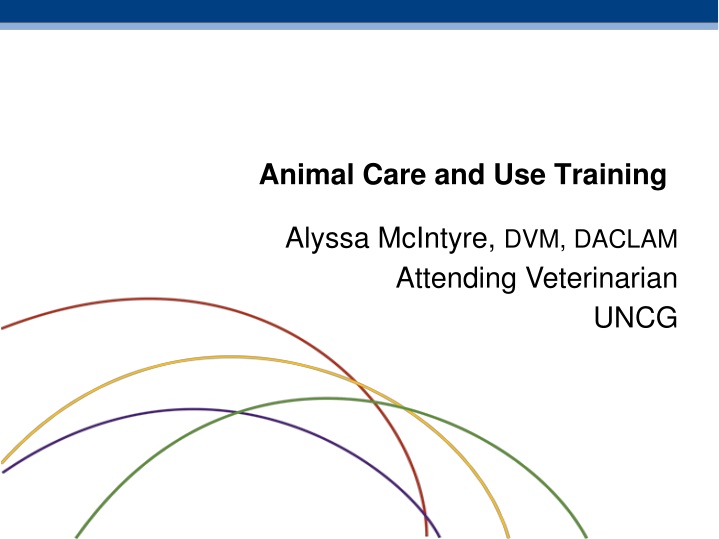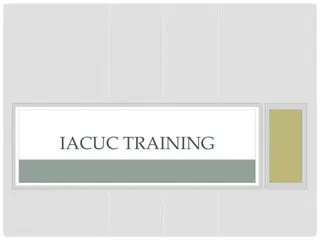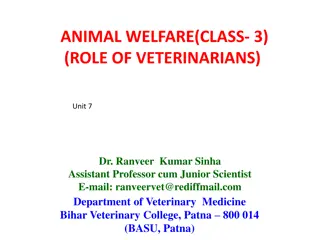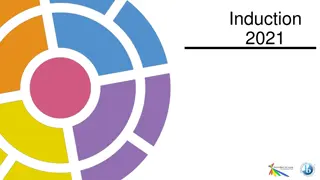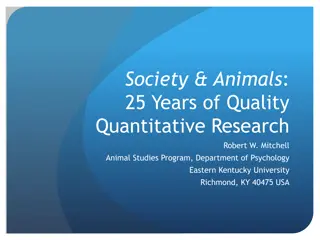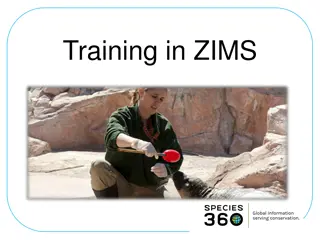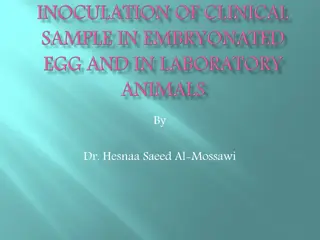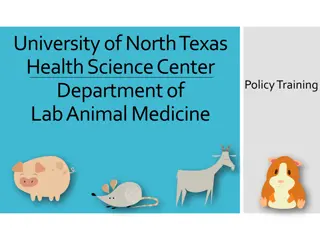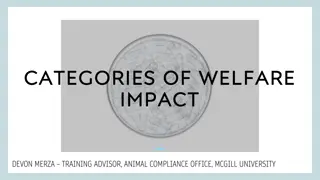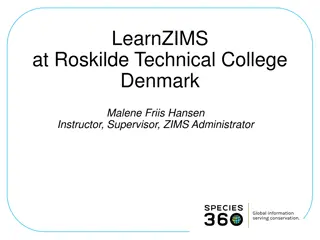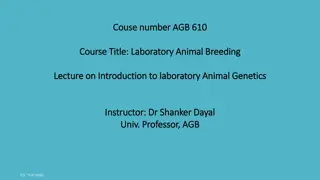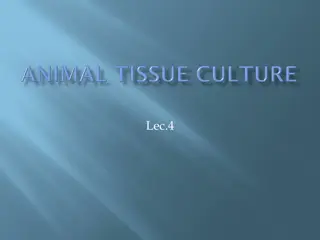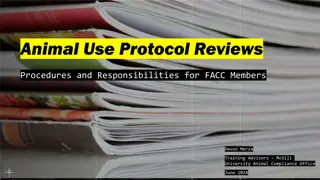Importance of Training in Animal Care and Use for Research
Training in animal care and use is essential to ensure humane and appropriate treatment of research animals, promote regulatory compliance, and uphold high standards of science and animal well-being. The presentation covers the necessity of training, goals including reviewing animal use and identifying national standards for animal welfare, reasons for using animals in research, and the importance of considering non-animal alternatives. Researchers must follow the 3 R's - Replacement, Reduction, and Refinement - when using animals for research purposes.
Download Presentation

Please find below an Image/Link to download the presentation.
The content on the website is provided AS IS for your information and personal use only. It may not be sold, licensed, or shared on other websites without obtaining consent from the author.If you encounter any issues during the download, it is possible that the publisher has removed the file from their server.
You are allowed to download the files provided on this website for personal or commercial use, subject to the condition that they are used lawfully. All files are the property of their respective owners.
The content on the website is provided AS IS for your information and personal use only. It may not be sold, licensed, or shared on other websites without obtaining consent from the author.
E N D
Presentation Transcript
Animal Care and Use Training Alyssa McIntyre, DVM, DACLAM Attending Veterinarian UNCG
Why is training necessary? Provide humane & appropriate research animal care Promotes regulatory compliance- USDA, PHS, the Guide Guide, 8th edition, on Training and Education: o All personnel involved with the care and use of animals must be adequately educated, trained, and/or qualified in basic principles of laboratory animal science to help ensure high-quality science and animal well-being... and the IACUC is responsible for providing oversight and for evaluating the effectiveness of the training program. All Program personnel training should be documented.
Goals of the Presentation Review animal use and alternatives to animal use Identify laws/guidelines that protect animals used in research Identify national standards for animal welfare Identify responsibilities for animal care and use at UNCG
Why are animal used in research? Living organisms with complex anatomic systems may respond differently to chemical or biological entities than simple, single celled organisms Current regulatory guidelines require the use of animals for testing unless there is an approved alternative Some basic research can t be done on a benchtop! Some advanced skills can t be taught using non-animal models/dummies
Non-animal alternatives must be used, when reasonable and available Legislation led to organizations looking for alternatives to animal testing The 1993 Revitalization Act charged the National Institutes of Health (NIH) with developing research methods that do not require animals, that reduce the number of animals used, and that produce less pain and distress in animals Interagency Coordinating Committee on the Validation of Alternative Methods (ICCVAM) was formed
Researchers are required to look for alternatives to using animals, and to use the 3 R s Best done when a project is in the planning stages One alternative is to look for an animal that is a lower species (rodents, insects, fish) When a non-animal alternative isn t available .. o Purchase only from reputable dealers o Use animals raised specifically for research o Treat with respect and compassion
The 3 Rs: Planning a research project What are the 3 R s ??? Reduction: o Reduce the number of animals used o Use enough to make the data valid Refinement: o Refine techniques and procedures to reduce pain and distress Replacement: o Replace animals with non-animal techniques or a lower species
Ethical commitment to animals Intentional Mistreatment of any animal is grounds for disciplinary action Anyone concerned that animals are being mistreated, used without IACUC approval, or used in ways the IACUC has not approved must report their concern o As outlined in regulations issued pursuant to the Animal Welfare Act and found in 9 CFR 2.31(c)(4), the IACUC is required to review, and, if warranted, investigate concerns involving the care and use of animals at the research facility resulting from public complaints received and from reports of noncompliance received from laboratory or research facility personnel or employees.
Whistle Blower Policy The USDA Animal Welfare Regulations provide protection against discrimination or other reprisals for reporting violations of the Animal Welfare Act ( whistleblower protection ). The regulations provide that No facility employee, Committee member, or laboratory personnel shall be discriminated against or be subject to any reprisal for reporting violations of any regulations or standards under the Act. (9 CFR 2.32(c)(4)). Source: USDA Regulations, 9 CFR Part 2, Subpart C, Section 2.31. Federal Register, August 31, 1989.
The UNCG Commitment to animal use in research, both on and off campus Animal use complies with: o State and Federal laws o Policies of the National Research Council/ILAR o Public Health Service Policy Russell and Burch s Three R s are the guiding principles for animal research
National Regulations: Animal Welfare Act and Animal Welfare Regulations USDA Enforcement Unannounced Inspections in facilities using USDA covered species annually o o Regulatory Authority was given to the USDA via congressional approval of the Animal Welfare Act, Animal Welfare Regulations o Additional detailed information is in the USDA Animal Care Policy Manual o Currently, UNCG does not have a license to house covered animals, so there are no inspections.
USDA Covered Species Living or dead animal which is: Dog, Cat, Non-human Primate, Guinea pig, Hamster, Rabbit, or any other warm-blooded animal used for, or intended for use in research, teaching, testing, experimentation, or exhibition, or as a pet except o Laboratory rats and mice and birds bred for use in research o Cold-blooded vertebrates
Public Funding: UNCG is required to follow Public Health Service (PHS) Policy Policy on Humane Care and Use of Laboratory Animals PHS Funding requires we follow the policy and have an Assurance document UNCG PHS Assurance is updated annually and describes our program for the care and use of animals in PHS- conducted or supported activities Office of Laboratory Animal Welfare (OLAW) provides guidance and interpretation of the Public Health Service (PHS) Policy and monitors compliance across the nation
LPHS funding requires UNCG to follow.. the Guide for the Care and Use of Laboratory Animals U.S. Government Principles for the Utilization and Care of Vertebrate Animals Used in Testing, Research, and Training AVMA Panel on Euthanasia OLAW requirements: FAQs, guidances, and Notices of Update to the Public Health Service Policy on Humane Care and Use of Laboratory Animals published online
U.S. Government Principles: A Review I. The transportation, care, and use of animals should be in accordance with the Animal Welfare Act (7 U.S.C. 2131 et seq.) and other applicable Federal laws, guidelines, and policies. Procedures involving animals should be designed and performed with due consideration of their relevance to human or animal health, the advancement of knowledge, or the good of society. II. III. The animals selected for a procedure should be of an appropriate species and quality and the minimum number required to obtain valid results. Methods such as mathematical models, computer simulation, and in vitro biological systems should be considered.
IV. Proper use of animals, including the avoidance or minimization of discomfort, distress, and pain when consistent with sound scientific practices, is imperative. Unless the contrary is established, investigators should consider that procedures that cause pain or distress in human beings may cause pain or distress in other animals. V. Procedures with animals that may cause more than momentary or slight pain or distress should be performed with appropriate sedation, analgesia, or anesthesia. Surgical or other painful procedures should not be performed on unanesthetized animals paralyzed by chemical agents. VI. Animals that would otherwise suffer severe or chronic pain or distress that cannot be relieved should be painlessly killed at the end of the procedure or, if appropriate, during the procedure.
VII. The living conditions of animals should be appropriate for their species and contribute to their health and comfort. Normally, the housing, feeding, and care of all animals used for biomedical purposes must be directed by a veterinarian or other scientist trained and experienced in the proper care, handling, and use of the species being maintained or studied. In any case, veterinary care shall be provided as indicated. VIII. Investigators and other personnel shall be appropriately qualified and experienced for conducting procedures on living animals. Adequate arrangements shall be made for their in- service training, including the proper and humane care and use of laboratory animals. IX. Where exceptions are required in relation to the provisions of these Principles, the decisions should not rest with the investigators directly concerned but should be made, with due regard to Principle II, by an appropriate review group such as an institutional animal care and use committee. Such exceptions should not be made solely for the purposes of teaching or demonstration.
Humane methods of animal maintenance and experimentation??? Basic needs of each species Proper handling and care of each species Proper pre- and post-procedural care Aseptic surgical methods and procedures All personnel involved in animal care and use will receive appropriate orientation and training in the care and ethical use of laboratory animals Source: USDA Regulations, 9 CFR Part 2, Subpart C, Section 2.31. Federal Register, August 31, 1989.
What regulations/guidelines must UNCG follow? All state and federal laws and regulations Guide for the Care and Use of Laboratory Animals (AKA the Guide ) AVMA Panel on Euthanasia PHS Policy US Government principles on the utilization of vertebrate animals in research OLAW Guidance
Law? Policy? Guidance? AWA / AWRs /ACP, the Guide, & PHS Policy o The AWA and AWRs are laws o Animal Care Policies are enforceable, detailed USDA interpretations of the laws o PHS Policy implements and supplements the U.S. Government Principles for the Utilization and Care of Vertebrate Animals Used in Testing, Research, and Training o The Guide is not a Law, but we need to follow it in order to get Public funding by PHS o Following OLAW Guidance is mandatory to obtain public funding
Overlapping Information AWA and AWRs: Short, sweet, dry, and lack details in many instances- and excludes rats and mice bred for research PHS Policy: Short, some things very detailed, some things not The Guide provides more detail that the AWRs, PHS Policy or US Government principles combined OLAW clarifies grey areas , gives details, and employs humans we can talk to rather than reading a book!
Summary Know what documents you need to follow!
Part II Guide for the Care and Use of Laboratory Animals Reporting issues at UNCG
The Guide for the Care and Use of Laboratory Animals Outline: o Key concepts for animal care and use o Animal Care and Use Program, including responsibilities of individuals and groups o Appropriate animal environment, housing and management o Veterinary medical care, including guidance for pain management and humane endpoints o Physical plant and facilities Rodents are included!!! (unlike the USDA)
The Guide for the Care and Use of Laboratory Animals Performance approach to animal care Not a how to manual! Revised and expanded Eighth edition published in 2011 Outlines responsibilities of the IACUC, Attending Veterinarian, the Institution, and more
Principles of the Guide: Institutional Responsibility An IACUC must be appointed by a CEO /senior authority Employ an Attending Veterinarian Provide training, methodologies, & alternatives Written program of Animal Care and Use Process for investigating deficiencies Many others
IACUC basics IACUC = Institutional Animal Care and Use Committee Comprised of at least 5 members (below) and their alternates o Community/ Non-affiliated Member (non-animal user) o Veterinarian o Scientist o Non-scientist o Another person (duplicate any of the above) An IACUC must have at least 5 members if the institution has a PHS Assurance and receives federal funding
IACUC Function and Responsibility Based on two federal laws o Health Research Extension Act of 1985 o AWA Amendments of 1985 Primary goal is to facilitate compliance with applicable laws, regulations and policies consistent with the performance of appropriate and productive scientific endeavors How do they do that?
IACUC responsibilities Inspect animal care and use areas- all areas housing animals (at least) every 6 months Semi-annual program review (program of humane care and use of animals) Submit reports of reviews and inspections to the Institutional Official every 6 months Suspend activities not in compliance Investigate deficiencies in animal care and use
IACUC responsibilities Review and Approve animal use protocols prior to research being performed Review all protocols annually and provide continuing oversight (post-approval monitoring) What does the IACUC need in order to do a thorough protocol review?
Protocol Review Criteria: Outlined in the Guide Protocol Review Criteria Scientific rationale and purpose of use A clear and concise sequential description of the procedures involving the use of animals that is easily understood by all members of the committee. Alternatives assessed (less invasive procedures, lower species, cell cultures) Justification of Species and number of animals, and experimental group size
Review Criteria, continued Unnecessary Duplication of experiments- or is duplication justified? Non-standard housing and husbandry requirements (Social housing with enrichment is standard) Impact of procedures on animal well-being Appropriate sedation, analgesia, and anesthesia Conduct of surgical procedures including multiple operative procedures.
Review Criteria, continued Post-procedural care and observation (e.g., inclusion of post-treatment or postsurgical animal assessment forms). Description and rationale for anticipated or selected endpoints Criteria and process for timely intervention, removal of animals from a study, or euthanasia if painful or stressful outcomes are anticipated. Method of euthanasia or disposition of animals, including planning for care of long-lived species after study completion (consider dogs, primates, birds, others)
Protocol Review Continued. Adequacy of training and experience of personnel in the procedures used, roles and responsibilities of personnel involved Use of hazardous materials and provision of a safe working environment. No use of paralytics without anesthesia
IACUC review of Painful Procedures Assume Human pain = Animal pain IACUC has the responsibility to verify that the Principal investigator has: o considered alternatives to animal use o use analgesics, anesthetics, tranquilizers (or justify their non-use) o consulted veterinarian for surgical protocols
Alternatives to Painful Procedures: Lit Search Required Written narrative must include: o Sources consulted: AWIC, MEDLINE, TOXLINE etc. o Years covered by the search o Key words/search strategy used o The strategy is not I used these 4 keyword combinations and didn t find anything o Written in such a way that the IACUC can readily determine if search was appropriate o Must address the three R s
Lit Search Info Search Services can be provided by National Library of Medicine (NLM) and National Agricultural Library (NAL) oThey can help you conduct a lit search that meets AWR requirements o They are free, and can provide an unbiased search Do-it-yourself lit searches: o Must include the refinements, reductions, and replacements o Written narrative- a paragraph o 99% of the time, there is an alternative- Explain why an identified, bona fide alternative method can t be used
Lit Search Info: NAL Recommendations Include the strategy page where you combined various keywords On Pubmed, this is the PUBMED Advanced Search Builder page Strategy page looks like (see next slide): Include a paragraph on why the references that appear to be duplicative/ alternatives are not pertinent.
History Download historyClear history Recent queries Add to builder Items found Search Query Time 13:29: #9 Add Search (euthanasia) AND mouse 430 53 13:29: #8 Add Search ((mouse) AND CO2) AND carbon dioxide 514 26 13:29: #5 Add Search CO2 59006 15 13:29: #4 Add Search carbon dioxide 99805 08 13:28: #3 Add Search euthanasia 24727 58 15655 13:28: #2 Add Search rat 23 48 13788 13:28: #1 Add Search mouse 94 40
IACUC responsibilities Utilize Protocol review criteria Verify the lit search was appropriate And more..
Attending Veterinarian Responsibilities: Direct housing and feeding of animals Provide adequate veterinary care Provide guidance to investigators Voting member of IACUC Guidance and oversight of surgery program and peri-operative care Ensure we follow current standards of animal care
The Guide: Information resource and guideline for standards in . Husbandry Environment Cage Sizes Enrichment Animal Procurement &Transportation Clinical Care and Management, Recordkeeping Animal Biosecurity
Principal Investigator Responsibilities Responsibilities: Appropriate species, strain and model Minimize number of animals Minimize pain and distress Consider alternatives (ICCVAM) Determine appropriate study and humane end-points Use acceptable methods of euthanasia
The UNCG Animal Care and Use Program and Use Program Since the Guide gives performance standards , how does UNCG meet those standards? o Training Programs- hands on and didactic training o Standard Operating Procedures for IACUC o Standard Operating Procedures for the Animal Facility o Animal Facility Manual and related policies document our processes to fulfill standards covered by the Guide In accordance with the Guide, all training for Program personnel should be documented
Animal Care or Welfare Concerns People within the facility are obligated to report: an animal is experiencing unanticipated pain or distress animals which may be being used in a manner that is not approved by the IACUC (suspected or known non- compliance) When you report a concern: Please be clear on what the concern is so it can be addressed in an appropriate timeframe!
Anyone who sees research animals should know the signs of pain or distress Abnormal ambulation, guarding limbs Anorexia, weight loss Rough hair coat Unusual posture, lethargy Vocalization upon palpation Abnormal voiding, emesis, diarrhea Swellings, masses or open wounds Unwilling to move, lethargy
Reporting animals in Pain or Distress Notify Principal Investigator and Facility Manager, Veterinarian Request a Veterinary Examination In accordance with the Guide: o Ensure timely and accurate information is conveyed to the responsible veterinarian about issues associated with animal health, behavior, and well being o The Attending Veterinarian should provide guidance .to ensure appropriate husbandry, handling, medical treatment .etc.
Reporting Possible Protocol Non- Compliance Examples of Non-compliance situations . o Animals in pain or distress not reported, not treated o Animals being used for experiments, training procedures, or in research methods that were not approved by the IACUC Contact: o Facility Manager Staff Veterinarian and/or IACUC Chair/members with concerns o UNCG ORI Office o Can be anonymous report
Reporting Possible Non-compliance Forgot who to contact already? Contact list is posted in the Animal facility hallway! o IACUC committee will investigate the issue with as much confidentiality as possible There will be no reprisals for reporting problems The IACUC is legally bound to review concerns
After this presentation you should understand the following and their applicability to UNCG: Laws and standards for the use of animals in Research (AWA/AWR, PHS, Guide) Basic principles for the use of animals in research (the 3 R s) How to identify and report Animal Pain/Distress How to report possible non-compliance IACUC Protocol review criteria and literature searches Please call or contact the Attending Veterinarian if you have any questions
